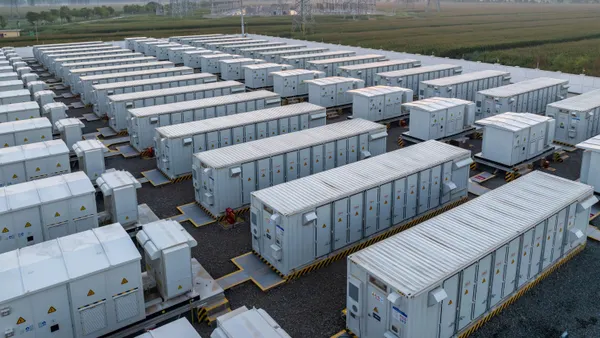Dive Brief:
- New York's Department of Public Services (DPS) on Monday issued two reports on energy storage development in the state — a unit-by-unit study of replacing or repowering peaking units in the state and a review of a DER Data Platform pilot.
- At least 275 MW of peaking units, or about 6% of the total rated capacity of New York's peaking fleet, were identified as potential candidates for replacement with six‐hour energy storage sized to the maximum 2013 output of each peaking unit, according to study. This number increases to over 500 MW when using eight‐hour duration storage.
- The DER Data Platform pilot is progressing as anticipated and DPS expects it to be operational by Dec. 31, the report said. The program will collect and store various types of customer and electric system data useful to DER developers, including average load, peak times, number and type of EVs and installed DER attributes, such as type and size.
Dive Insight:
Replacing New York's fleet of less efficient peaking units with energy storage systems and renewables will be key to achieving the state's clean energy goals. New York aims to reduce greenhouse gas emissions 40% by 2030 and shift to 100% clean electricity by 2040.
Democratic Gov. Andrew Cuomo earlier this year announced proposed regulations to accelerate this plan. The governor's proposal includes lower thresholds for nitrogen oxide (NOx) emissions from simple cycle and regenerative combustion turbines, and would phase in control requirements from 2023 to 2025. Gas-fired peaker plants, which generate infrequently, can account for more than a third of the state's daily power plant NOx emissions when they run.
The DPS peaker replacement study showed that when considering the ability of storage to hybridize, which refers to installing energy storage at an existing conventional peaker unit, standalone four‐hour storage has the ability to bring 864 MW of peaking units into compliance with the daily NOx limit.
"[In] New York state, storage is an option today to replace some of these peaking units, and could be an option today for hybridization ... to bring the peaker into compliance with the new proposed NOx rules," Shuyler Matteson, project manager, energy storage at the New York State Energy Research and Development Authority (NYSERDA), told Utility Dive.
The study further showed that pairing solar with storage at conventional units could result in 1,804 MW of peaking units in compliance with DEC's proposed NOx rule.
NYSERDA did not include any financial estimations in its report due to the "huge variability in the economics of the individual clients," Matteson said.
“We believe that storage technologies will benefit the grid and help the state in meeting its emissions goals. We agree with the DPS that a more thorough analysis of the peaker rule will be needed to provide assurance that reliability will be maintained throughout this transition," the New York Independent System Operator (NYISO) told Utility Dive in an email.
NYISO will examine the state's proposed peaker emissions rules and potential impact on system reliability in its upcoming 2020 Reliability Needs Assessment.
"That analysis will incorporate expected system conditions during the period of peaker rule implementation, including the planned deactivation of Indian Point and expanded transmission capabilities," NYISO said.
Units 2 and 3 of the Indian Point nuclear power plant, which have a combined 2 GW of capacity, are scheduled to retire in April 2020 and April 2021, respectively.
Across the country, as much as 32% of new gas peaker capacity will be at risk from four-hour energy storage by 2027, GTM Research said in a March report. GTM said the costs of storage are dropping at a rate that will allow it to start being competitive with new peaking plants in about five years. But ten years from now, energy storage will “almost always” win out over the cost of a new peaking plant.













